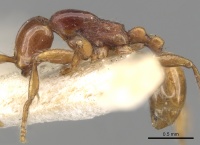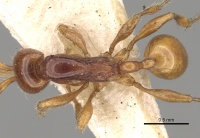Aenictus peguensis
| Aenictus peguensis | |
|---|---|

| |
| Scientific classification | |
| Kingdom: | Animalia |
| Phylum: | Arthropoda |
| Class: | Insecta |
| Order: | Hymenoptera |
| Family: | Formicidae |
| Subfamily: | Dorylinae |
| Genus: | Aenictus |
| Species group: | minutulus |
| Species: | A. peguensis |
| Binomial name | |
| Aenictus peguensis Emery, 1895 | |
No biological information is available for A. peguensis. However, judging from the type locality and the locality of non-type material examined this species inhabits lowlands.
Identification
A member of the minutulus species group. Jaitrong and Yamane (2011) - Aenictus peguensis is most similar in general appearance to Aenictus subterraneus but is distinguished from the latter as follows: distinctly larger than the latter (total length 2.95–3.25mm, head width 0.52–0.60mm in A. peguensis; total length 2.10–2.15mm, head width 0.48–0.50mm in the latter); propodeal junction angulated, right-angled (roundly angulated in the latter); with head in full-face view posterior margin convex (feebly concave in the latter).
Keys including this Species
Distribution
Latitudinal Distribution Pattern
Latitudinal Range: 32.0744° to 5.016666667°.
| North Temperate |
North Subtropical |
Tropical | South Subtropical |
South Temperate |
- Source: AntMaps
Distribution based on Regional Taxon Lists
Oriental Region: India, Myanmar (type locality), Vietnam.
Distribution based on AntMaps
Distribution based on AntWeb specimens
Check data from AntWeb
Countries Occupied
| Number of countries occupied by this species based on AntWiki Regional Taxon Lists. In general, fewer countries occupied indicates a narrower range, while more countries indicates a more widespread species. |

|
Estimated Abundance
| Relative abundance based on number of AntMaps records per species (this species within the purple bar). Fewer records (to the left) indicates a less abundant/encountered species while more records (to the right) indicates more abundant/encountered species. |

|
Biology
Castes
Known only from the worker caste.
Nomenclature
The following information is derived from Barry Bolton's Online Catalogue of the Ants of the World.
- peguensis. Aenictus peguensis Emery, 1895k: 452 (w.) MYANMAR.
- Type-material: lectotype worker (by designation of Jaitrong & Hashimoto, 2012: 38); 17 paralectotype workers.
- [Note: Baroni Urbani, 1977e: 66, cites 3w syntypes NHMB.]
- Type-locality: lectotype Myanmar (“Burma”): Palon, at Pegu, 8.ix.1887 (L. Fea); paralectotypes with same data.
- Type-depositories: MSNG (lectotype); MSNG, NHMB (paralectotypes).
- Subspecies of ceylonicus: Forel, 1901a: 477; Emery, 1910b: 29; Chapman & Capco, 1951: 11.
- Status as species: Bingham, 1903: 22; Wilson, 1964a: 471; Bolton, 1995b: 60; Bharti, Wachkoo & Kumar, 2012: 294 (in key); Jaitrong & Hashimoto, 2012: 38 (redescription); Bharti, Guénard, et al. 2016: 21; Wong, M.K.L. & Guénard, 2016b: 37 (in key); Khachonpisitsak, et al. 2020: 31.
- Distribution: India, Myanmar, Thailand, Vietnam.
Unless otherwise noted the text for the remainder of this section is reported from the publication that includes the original description.
Description
Worker
Jaitrong and Hashimoto (2012) - Measurements. Lectotype: TL 3.25 mm; HL 0.73 mm; HW 0.60 mm; SL 0.48 mm; ML 1.00 mm; PL 0.23 mm; CI 83; SI 79. Paralectotypes (n = 5): TL 2.95–3.15 mm; HL 0.60–0.70 mm; HW 0.52–0.58 mm; SL 0.40–0.45 mm; ML 0.88–0.95 mm; PL 0.20–0.23 mm; CI 82–96; SI 74–79.
Lectotype and paralectotypes - Head in full-face view slightly longer than broad, with convex sides and feebly convex posterior margin; occipital margin bearing a carina. Antennal scape reaching midlength of head; antennal segments II–X each longer than broad; II and III slenderer than IV–VI; terminal segment almost as long as VII+VIII+IX and 2.4 times as long as broad. Frontal carina short, posteriorly fused to form a single carina, slightly extending beyond the level of posterior margin of torulus. Masticatory margin of mandible with a large apical tooth followed by a medium–sized subapical tooth, 5–6 denticles, and a medium-sized basal tooth; basal margin with 4–5 small denticles. Promesonotum in profile strongly convex dorsally and sloping gradually to metanotal groove; metapleural gland bulla relatively small and transparent; distance between propodeal spiracle and metapleural gland bulla clearly longer than spiracular diameter (Fig. 5E). Propodeum in profile with convex dorsal outline; propodeal junction right-angled; declivity of propodeum seen from back convergent above. Petiole excluding subpetiolar process shorter than high, with its dorsal outline convex; subpetiolar process rather developed, with a sharply pointed lamellate appendage directed downward. Postpetiole clearly shorter than petiole, its dorsal outline convex.
Head including mandible and antennal scape smooth and shiny; basal portion of scape finely sculptured. Entire pronotum smooth and shiny except for its anteriormost portion punctate; mesothorax, petiole, and postpetiole entirely punctate but metapleuron at least partly impunctate. Legs entirely smooth and shiny. Head and mesosoma dorsally with relatively sparse standing hairs mixed with sparse short hairs over the surface; longest pronotal hair 0.18–0.23 mm long. Head, pronotum and gaster yelwish-brown; methothrax, propodeum, waist darker and often slightly reddish.
Type Material
- Lectotype (designated by Jaitrong & Hashimoto, 2012: 38), worker, Palon, at Pegu, Myanmar, 8 September 1887, L. Fea, Museo Civico di Storia Naturale, Genoa.
- Paralectotype (designated by Jaitrong & Hashimoto, 2012: 38), 17 workers, Palon, at Pegu, Myanmar, 8 September 1887, L. Fea, Museo Civico di Storia Naturale, Genoa.
References
- Bingham, C. T. 1903. The fauna of British India, including Ceylon and Burma. Hymenoptera, Vol. II. Ants and Cuckoo-wasps. London: Taylor and Francis, 506 pp. (page 22, revived status as species)
- Emery, C. 1895m. Viaggio di Leonardo Fea in Birmania e regioni vicine. LXIII. Formiche di Birmania del Tenasserim e dei Monti Carin raccolte da L. Fea. Parte II. Ann. Mus. Civ. Stor. Nat. 34[=(2(14): 450-483 (page 452, worker described)
- Forel, A. 1901a. Les Formicides de l'Empire des Indes et de Ceylan. Part VIII. J. Bombay Nat. Hist. Soc. 13: 462-477 (page 477, subspecies of ceylonicus)
- Jaitrong, W. & Hashimoto, Y. 2012. Revision of the Aenictus minutulus species group (Hymenoptera Formicidae Aenictinae) from Southeast Asia. Zootaxa 3426, 29-44.
- Khachonpisitsak, S., Yamane, S., Sriwichai, P., Jaitrong, W. 2020. An updated checklist of the ants of Thailand (Hymenoptera, Formicidae). ZooKeys 998, 1–182 (doi:10.3897/zookeys.998.54902).
- Wilson, E. O. 1964a. The true army ants of the Indo-Australian area (Hymenoptera: Formicidae: Dorylinae). Pac. Insects 6: 427-483 (page 472, see also)
References based on Global Ant Biodiversity Informatics
- Bharti H. 2011. List of Indian ants (Hymenoptera: Formicidae). Halteres 3: 79-87.
- Bharti H., A. A. Wachkoo, and R. Kumar. 2017. First inventory of ants (Hymenoptera: Formicidae) in Northwestern Shivalik, India. Halteres 8: 33-68.
- Chapman, J. W., and Capco, S. R. 1951. Check list of the ants (Hymenoptera: Formicidae) of Asia. Monogr. Inst. Sci. Technol. Manila 1: 1-327
- Fayle T. M., E. C. Turner, J. L. Snaddon, V. Khen Chey, A. Y. C. Chung, P. Eggleton, and W. A. Foster. 2010. Oil palm expansion into rain forest greatly reduces ant biodiversity in canopy, epiphytes and leaf-litter. Basic and Applied Ecology 11: 337345.
- Forel A. 1901. Les Formicides de l'Empire des Indes et de Ceylan. Part VIII. J. Bombay Nat. Hist. Soc. 13: 462-477
- Jaitrong, W., and Y. Hashimoto. "Revision of the Aenictus minutulus species group (Hymenoptera: Formicidae: Aenictinae) from Southeast Asia." Zootaxa 3426 (2012): 29-44.
- Khachonpisitsak S., and S. Lopwichan. 2016. New record of the ant genus Aenictus Shuckard, 1840 (Hymenoptera: Formicidae: Dorylinae) from Thailand. The Thailand Natural History Museum Journal 10(1): 53-59.


